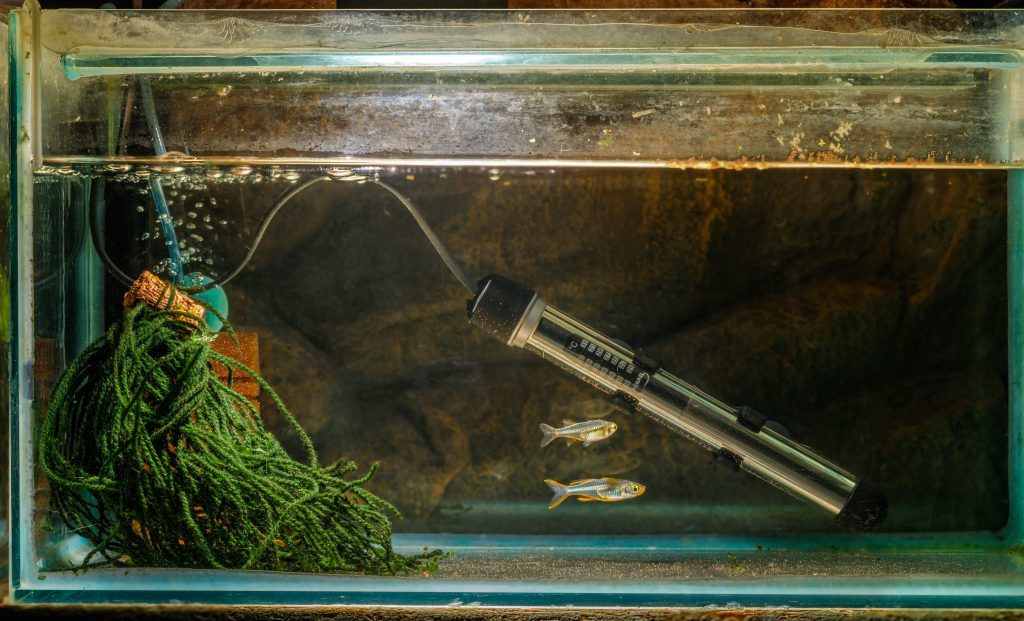Jennifer O. Reynolds, M.A. & Nora Hickey, D.V.M.
Looking for great beginner fish to start your aquarium? Nora and Jen’s top picks are easy to care for fish that can make excellent additions to community tanks. Starting with platy fish, fighting fish, cory catfish, and others can help kick off your fishkeeping hobby with success.
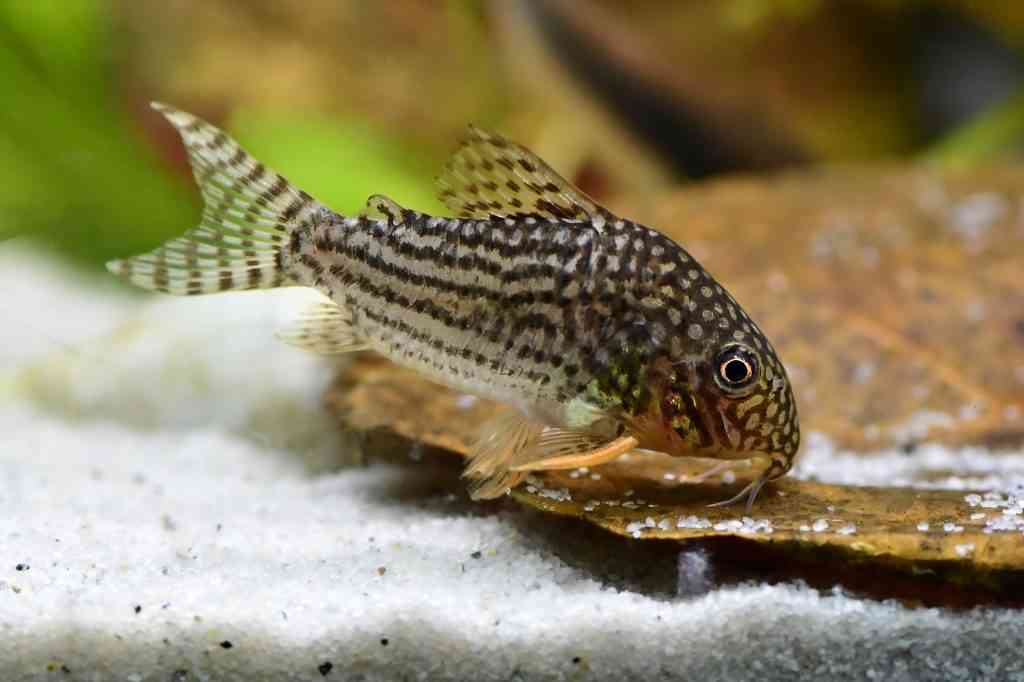
Corydoradinae Catfish
Nora: Let’s start with my absolute favorite, Jen–Corydoradinae catfish! They are adorable, and so interesting. There are many different species, and most are easy to keep as long as you make sure to feed them special sinking wafers.
Jen: One of the things I love most about them is that they wink. If you watch one for a while resting on the bottom, they’ll roll one little eye back at a time. Aside from that, they’re industrious. I appreciate a fish as concerned about finding every crumb as I am.
Nora: And to go easy on their little whiskers and mouths, they definitely appreciate a sandy bottom in the tank. They do require a school. I recommend at least three, but can you ever have too many cory cats? I also enjoy their little dashes up to the surface, where they suck an air bubble into their mouth and then release it when they’re back at the bottom. They’re peaceful and always relaxing to watch.
Jen: That’s right, since they can breathe air, they will sometimes dash to the surface to supplement their oxygen needs. I also recommend going big or going home when it comes to keeping your cory cats in groups. They really thrive with the company of others.
Nora: Do you have a favorite species? I like pandas (Hoplisoma panda) and peppered corys (Hoplisoma paleatum).
Jen: My favorite would have to be the Hoplisoma sterbai. There is nothing cuter than baby sterbai, and I had the pleasure of rearing those when I worked at the Vancouver Aquarium. They have beautiful orange pectorals, a short snout, and complex pattern. They’re the perfect cory cat, to me.
Tips for Successful Cory Keeping:
- Keep in a group of at least three, preferably six corys of the same species
- Ensure you offer sinking food so they get enough to eat
- Best substrate choice is barbel-friendly, such as sand
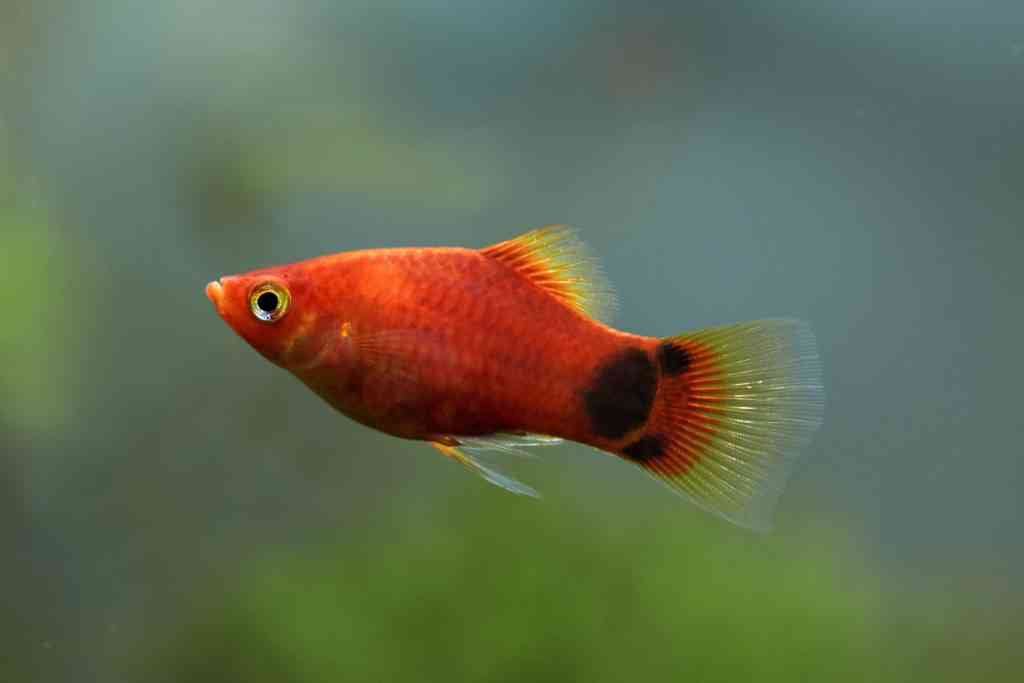
Platys (Xiphophorus maculatus)
Jen: Platys have got to be one of my personal top fish that I recommend. I just have such great memories of these when I was a kid. You can pick out different colors and patterns so you can tell them apart, they’re easy to breed, and then you get to see the little ones grow and develop different colors depending on their genetics. It’s a thrill for kids and honestly still a thrill for me as an adult.
Nora: They’re another active swimmer that adds a good energy to a community tank, and they’re exceptionally peaceful.
Jen: They also eat algae…again, I appreciate fish who are working as hard as I am to keep their tank clean!
Nora: And there are so many colors and patterns to choose from. The Mickey Mouse platies are nostalgic for me, I remember seeing those at the fish store I went to as a kid.
Jen: Mickey Mouse platies are definitely nostalgic. I still remember two of the specific ones I had as a kid—one male who was shiny blue and a female who was pale yellow. As far as care goes, they do appreciate mineral-rich water with a higher pH, so they can be a good beginner fish for people whose water naturally has this water chemistry.
Nora: They’re cute and colorful. Really an ideal choice.
Jen: One thing to note is it’s better to have more females than males. The classic recommendation is one male for every two to three females, because the males can be incessant in their attempts to breed. This is the case for many livebearer species.
Tips for Successful Platy Keeping:
- Try to keep two to three females for every one male
- Benefit from mineral rich, slightly higher pH water than many other community fish
- Will breed easily (they are livebearers and give birth to live fry)

Siamese fighting fish (Betta splendens)
Jen: Bettas are so popular for good reason. They can be great fish to start with. Although I don’t necessarily consider bettas community fish, sometimes a female betta can work well with others, or a male may work with some of the species here. In any case, one betta per tank is the way to go.
Nora: They are by far the most interactive fish on this list. If you’re looking for a first fish that has a personality, a betta is it. Another benefit is that you can keep them in a smaller set up than a standard community tank, although I believe a heater is essential.
Jen: It’s definitely important to give them a proper aquarium with a filter, heater and enough room to swim. A happy, well-cared for bettas displays its best colors and personality.
Nora: They are flashy! And there are just so many varieties to choose from. You and I have a history of being serious plakat enjoyers. I personally have a secret love of dumbos. And the black, blue, and iridescent colors are my favorites.
Jen: The amazing varieties available these days are definitely what drew me back in. The koi varieties, especially those half moon plakats, are irresistible to me. Although sometimes their health and longevity isn’t as good as the bettas I had 20 years ago, since they’ve been line bred so extensively.
Nora: And you want your betta to live forever, because you get so attached. They are wonderful little fish!
Tips for Successful Betta Keeping:
- Require a heater
- May or may not mix well with other community fish
- Minimum tank size is a 5-gallon aquarium
Click here to read our “Betta Care for Beginners” Article
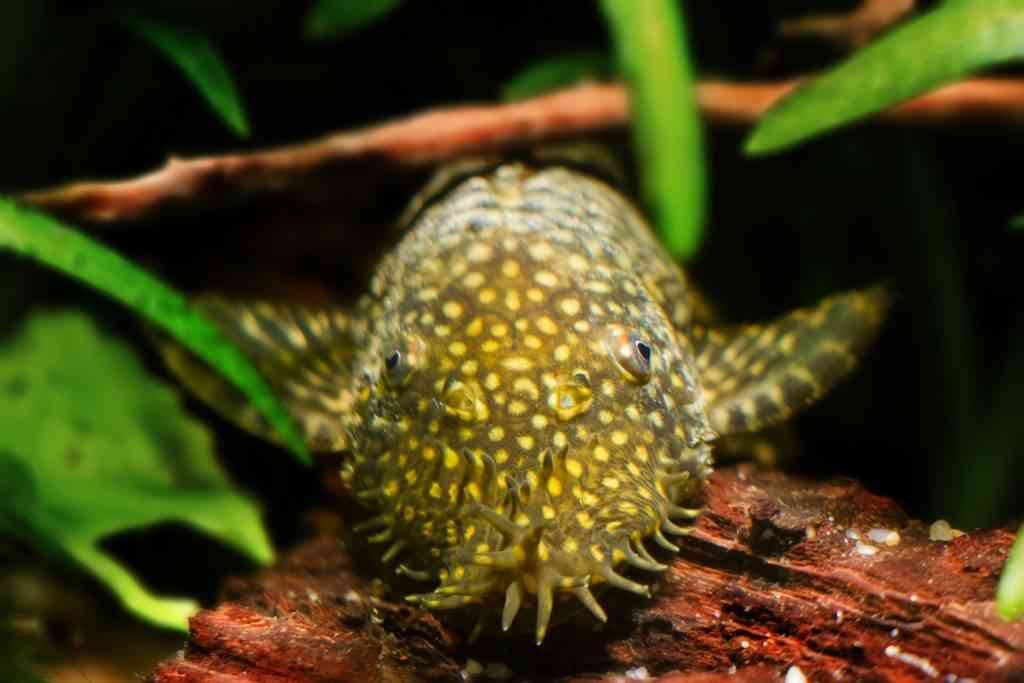
Bristlenose Plecos (Ancistrus spp.)
Jen: So another fish that is very popular with both beginner and advanced hobbyists, and with good reason, are the Ancistrus catfish, or bristlenose plecos. When I was young, we only had the huge plecos, Hypostomus plecostomus, available, which outgrew an average aquarium way too easily. Luckily these days, Ancistrus are common. They stay small and also have a great personality. Kids especially love seeing them suck onto the front glass.
Nora: They round out a tank and are a super peaceful, chill addition to a community tank that helps keep the algae under control. They definitely like to hide and are more nocturnal, but they will come out for algae wafers and fresh vegetables. It’s important to have dark hiding places for them, feed them their own special food, and ideally provide driftwood, which they appreciate. They’re the more “shy” fish that is always rewarding to see when they do come out.
Jen: I agree. It’s fun to have a fish that you have to look around for sometimes. It makes it more special when they do come out.
Nora: It’s also cool that the males get the wild bristles on their snouts! I have a weakness for the albinos, but there are actually quite a few varieties of these guys that you can choose from.
Jen: The bristles are very goofy. Personally I like the wild types, but I know there are long-finned ones, red ones, and albinos that people really enjoy.
Nora: Every Ancistrus is a good Ancistrus!
Jen: I couldn’t agree more.
Nora: As a special treat, it is fun to give them various fresh veggies to nibble on. I did pumpkins around Halloween, and they loved it! There are also excellent wafers available especially for feeding them.
Jen: Yams, zucchinis, cucumber, all of that. They do work away those, and it’s fun to watch. They’re loricariid catfish, which is a huge family and one that some aquarists exclusively specialize in, so be careful if you get hooked on the Ancistrus! It could be the beginning of a lifetime hobby of suckermouth catfish.
Nora: True! I always have the problem of maxing tanks out on catfish and then having to come up with non-bottom dwellers to fill in the rest of the water column.
Tips for Successful Ancistrus Keeping:
- Provide hiding places and driftwood
- Tend to be nocturnal but will learn to come out in the day for food
- Provide special vegetable-based wafers and/or boiled or frozen fresh vegetables

Zebra Danios (Danio rerio)
Nora: Okay, another classic: zebra danios. These were in my very first fish tank that my grandpa gave me!
Jen: So danios have a special place in your heart! What did you love about them as kid?
Nora: They add a lot of movement and activity to a tank. They are schooling fish, so you should get at least three to five, and then you can just sit and watch them swim around! They’re also very pretty fish. There are a lot of different species of danios besides the classic zebra danio, as well as varieties of zebra danios with different fins and colors. And they are easy keepers! All around, a great first fish. One key with them is that you have to have a good tank cover, because they will jump out.
Jen: Zebra danios are unquestionably one of the most basic, great starter fish. They never stop moving, eat just about anything, and are beautiful. And if you can catch a glimpse of their face long enough as they zip around, you’ll see that because they are cyprinids (related to carp and minnows), they have charming little whiskers (barbels) on their mouths. They also deserve a special mention for their contribution to scientific research for several decades now. They’ve been used extensively as a model organism for biomedical and other research.
Tips for Successful Zebra Danio Keeping:
- Ensure their aquarium has a tight-fitting cover to prevent jumping out
- Maintain in a group of at least three to five
- Many different varieties and species to choose from
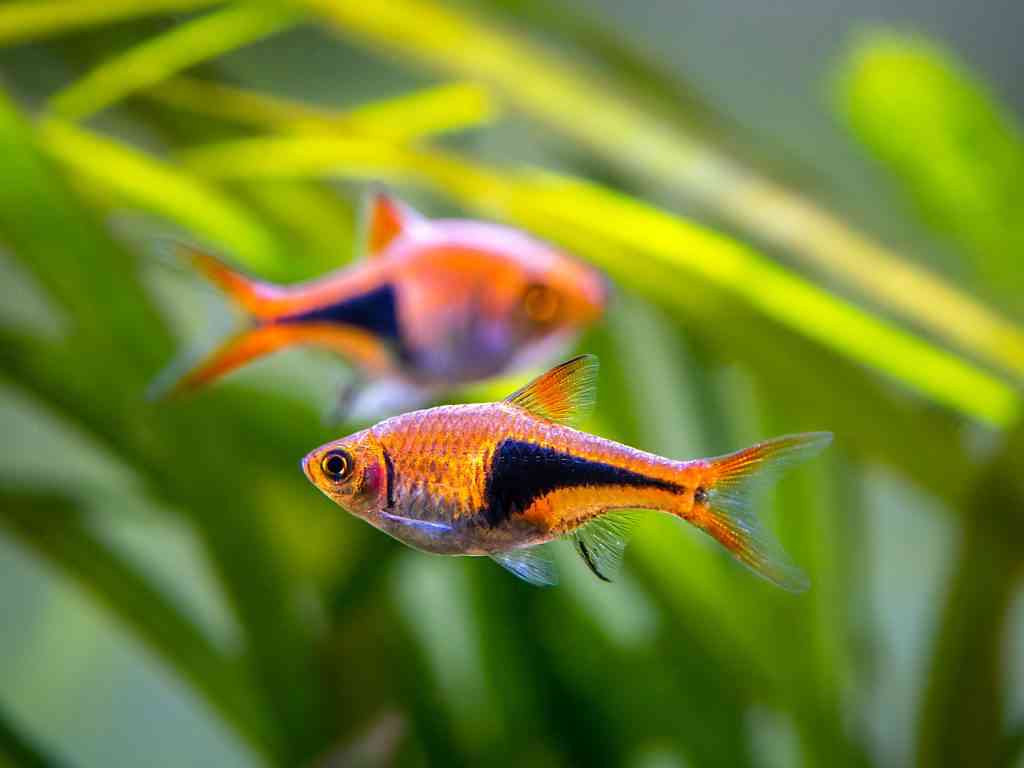
Harlequin Rasboras (Trigonostigma heteromorpha)
Nora: I had these fish as a kid. This year my mom sent me one of my old Christmas ornaments that was one of those baked ornaments with a fireplace and stockings hanging on it; I had labeled each stocking with my pets’ names, including the harlequin rasboras we had in our community tank at the time. I remember them being very fun fish to draw pictures of!
Jen: That’s true! A nice black triangle would be a fun one to draw. What I like about harlequins is they stay small, have beautiful rich pink colouration that isn’t common among the other species we mention, and they form a nice loose shoal which contrasts well with faster schooling fish like the danios. They tend to hang out in the middle of the water column, are more or less trouble-free, available in almost every fish store, and are pretty adaptable to different water conditions. They’re just an all around solid choice for a beginner community tank.
Nora: Agreed. They’re social, so this is another species where keeping a minimum of three to five is important. My downstairs neighbors are keeping a big group of these fish right now in their planted aquarium, and they look great! It’s a species that I might want to revisit. I haven’t kept these in awhile, and they really are the classic beginner aquarium fish!
Tips for Successful Harlequin Rasbora Keeping:
- Keep in a group of at least three to five
- Easy to find at any aquarium store
- Very hardy
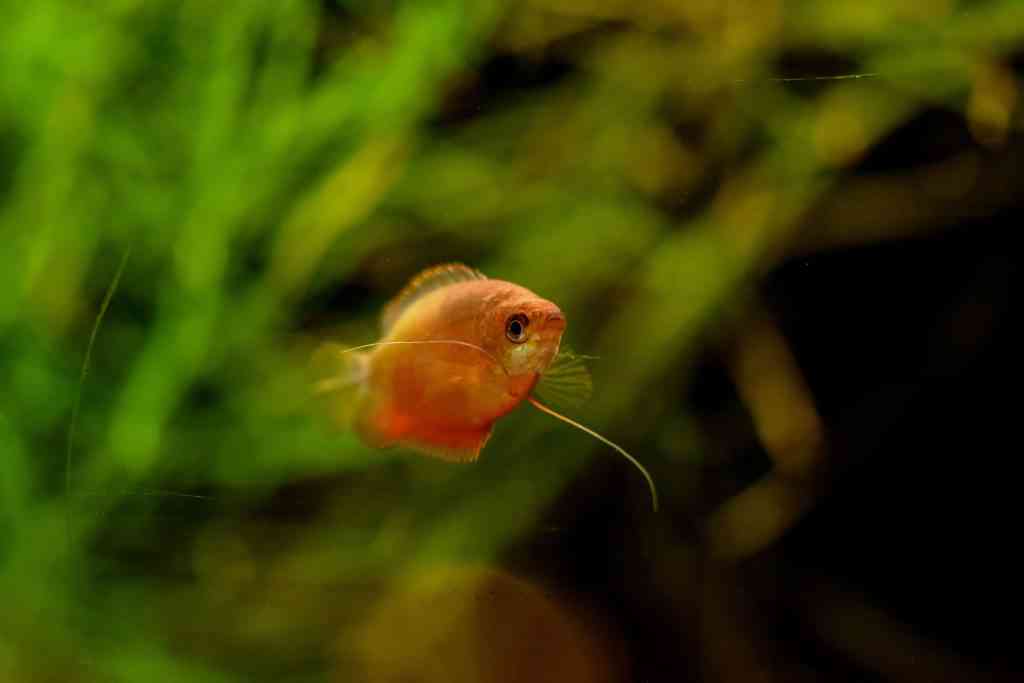
Honey Gouramis (Trichogaster chuna)
Jen: Every aquarium needs its star though. It’s good to pick fish that occupy different areas of the aquarium and different sizes of fish for visual interest. Honey gouramis fit the bill here because they stay smaller than many other gourami species and are brightly-colored. They’re charming as they come with their “feelers” (modified pelvic fins), which they’ll tentatively use to explore your finger or arm when you’re cleaning.
Nora: Whereas most of the other community fish we mentioned are schooling swimmers, gouramis are intentional explorers of their environment. They also get a bit bigger than the other fish we’ve mentioned, so they are a nice “centerpiece” you can focus on and watch for quite awhile.
Jen: In terms of how many to keep together, it depends on the size of the tank. Usually these guys are best in a small group where females outnumber males. Fortunately, since they’re a small gourami, if you end up with more than one male it’s not a disaster with the honey gouramis. Larger gourami species can sometimes be aggressive.
Nora: I remember we had two opaline gouramis (Trichopodus trichopterus) in a tank as a kid, and one of them drove the other to live in the area under the undergravel filter.
Jen: Yes, larger gouramis like the opalines/blues can be bad choices for the average community aquarium. With honey gouramis, females can get a bit bigger and can also squabble with one another, but this really is among the most peaceful of the gouramis. If a male starts defending a territory or is considering spawning, his color can really intensify and be quite stunning. The social behavior of these fish is enjoyable. Like you said, they’re very intentional in their movements, and that is a quality I really look for in my favorite species these days. They’ll feel more comfortable cruising around when they have plants and some hiding areas nearby. Another interesting note is they’re labyrinth fish, like bettas, so they can also breathe air.
Nora: Having plants and decor also helps break up their line of sight, which can minimize chasing and aggressive behavior.
Tips for Successful Honey Gourami Keeping:
- Keep more females than males in the group
- Provide cover with plants, wood, etc., to provide some hiding areas in case of squabbles and to help them feel comfortable
- A bigger fish for your community aquarium with more complex, interesting behavior than some of the schooling species we mention here
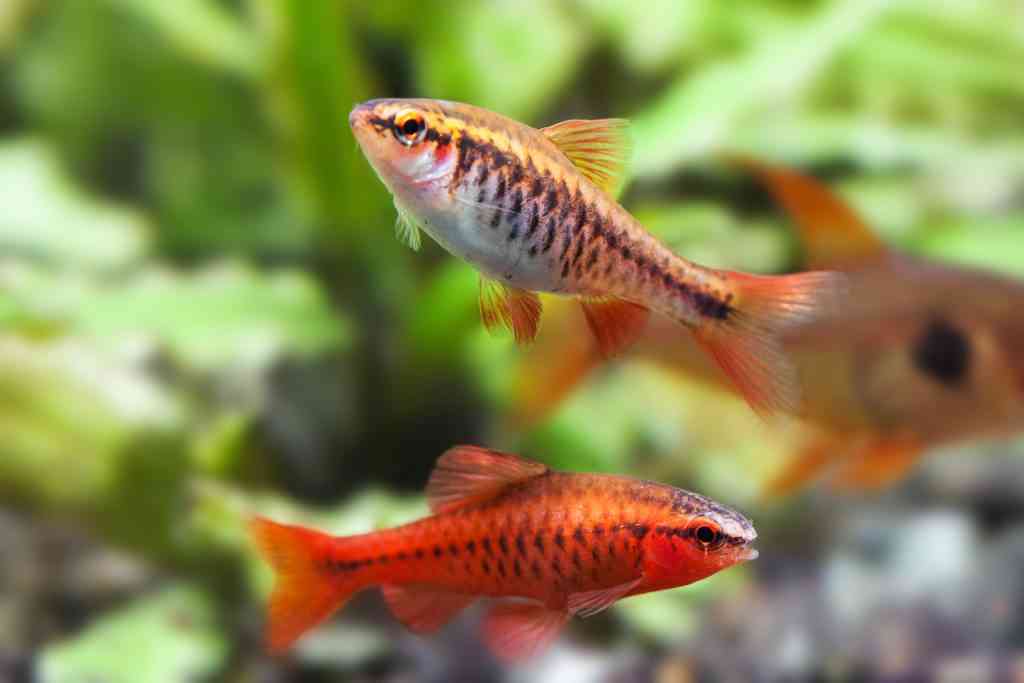
Cherry barbs (Puntius titteya)
Nora: Now it’s time for another classic—cherry barbs! I thought they were called “cherry bars” when I was little. Like an ice cream treat or something. They are spectacularly-colored—the males are a popping bright red!
Jen: And don’t forget the little barbels these guys sport as well.
Nora: Since they’re barbs, they can be a little bit nippy, so not good tank mates for fish with long, flowing fins or weak swimmers. They also school, are active swimmers, and are wonderful little red gems that stand out in your aquarium!
Jen: I see them as more of a shoaling fish, at least in comparison to something like the danios which move in more of a tight group. They do hang out together, and they occupy a very specific area in the aquarium where they like to be sort of near the bottom, but not all the way at the bottom. I think of them as a fish for the lower third of the aquarium, although they do explore everywhere. I have seen males squabble at times.
Nora: I think they look especially dramatic in a planted tank, where they stand out vividly against the greenery! They’re also fun because you can easily tell males and females apart. The females get big, fat bellies full of eggs, and they’re not quite as red as the males…which are just these stunningly bright red little torpedoes.
Jen: They’re downright dramatic as-is, and if the natural cherry-colored version isn’t enough for you, there are some albino and long-finned types available as well. They’re just an easy fish overall and stay small.
Tips for Successful Cherry Barb Keeping:
- Keep in a small group with more females than males
- Avoid tank mates that have long flowing fins or are weak swimmers (such as fancy guppies, veiltail bettas, long-finned varieties of fish)
- Brilliantly-colored fish that add a bright red color to your community tank
Try these fabulous fish species whether you’re a beginner or advanced hobbyist to feel the…

